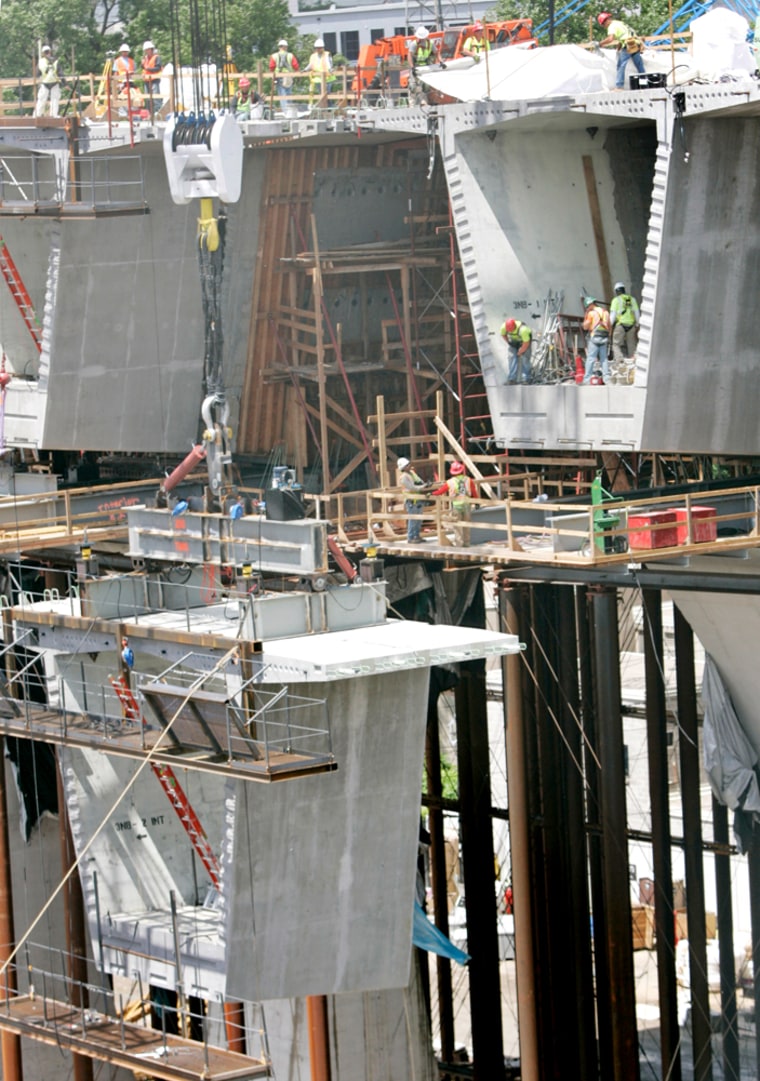Two halves of a sparkling new Interstate 35W freeway bridge stretch toward each other over the Mississippi River, separated by a gap of about 200 feet that shrinks with each day as workers toil around the clock.
The old bridge collapsed last Aug. 1, killing 13 people and severing a critical link in the state's largest city. But for the companies replacing it, the goal is more than just restoring traffic flow — finishing ahead of schedule could mean up to $27 million in extra payouts.
That carrot has the new bridge on track to open as early as September, three months before it must be finished under the builders' contract with the state.
"Things are getting done in days and weeks that normally take months and years," said Kevin Gutknecht, spokesman for the Minnesota Department of Transportation. "But the bottom line is there's 141,000 cars a day that have to go someplace else right now, and that's hard on everyone."
Much higher costs
Project planners considered an alternate approach known as accelerated bridge construction, but that carries much higher costs.
Bill Halsband, vice president at Mammoet USA, a Texas accelerated construction firm that unsuccessfully bid for subcontracting work on the Minneapolis bridge, said he's not aware of any previous bridge of this size that's gone up so fast using conventional construction methods.
"Anything can be done if people put their minds and their wallets to it," Halsband said.
The main contractors, the team of Flatiron Constructors of Longmont, Colo., and Manson Construction of Seattle, submitted a bid of $234 million with a timetable of 437 days. The bid was the most expensive and lengthiest of the four submitted, but scored higher than the others on factors such as quality and aesthetics.
The builders could earn even more, depending on how soon the project is finished: an additional $7 million for finishing by the final deadline of Dec. 24, and an additional $2 million for every 10-day period prior to the final deadline, up to 100 days.
If the bridge is ready for vehicles to drive across it by Sept. 15, the contractors earn the full $27 million bonus — a goal Flatiron/Manson assistant project manager Bob Edwards said is achievable. Project managers said they should be able to set a firm opening date by the end of July.
Gutknecht said there's no reason to think the rapid pace will compromise safety. He said several layers of quality control include outside inspection of the plans, and of each stage of the work before it happens. MnDOT also has a team of inspectors on site, constantly reviewing every facet of the job.
"You want to do it right the first time," Gutknecht said. "If you make a mistake and have to do it over, it costs time and money."
Bridge builders have advantages
In keeping up their pace, the bridge builders have some advantages not available in more traditional traffic construction projects.
"We're in the middle of a major downtown, yet we have no traffic because the old bridge collapsed," Edwards said. "We have no traffic to fight. We don't have to rebuild half the bridge and then come back and rebuild the other half of the bridge. We just get to do it all in one fell swoop."
Construction crews work around the clock, in 12-hour shifts. They worked through the coldest days of last winter, and stop only for lightning or extremely high winds. At the height of activity a few weeks ago, there were 600 construction workers at the site; the number has dropped to about 450.
The concrete segments of the bridge are being cast on site. The pieces are carried on a flatbed truck to a staging area a few hundred yards down the river, then loaded onto a barge and ferried up to the new bridge. A massive crane nicknamed "Big Ben," which sits atop another barge, lifts them into place.
Workers attached by ropes to more stable parts of the bridge dangle about a hundred feet above the river, attaching segments with high-tension steel cables and wires that will run the length and width of the bridge.
Different design
The new bridge has a different design than the old bridge, which was "fracture critical" — meaning when one part failed, the whole bridge fell.
"This is a redundant structure," Gutknecht said of the new bridge. "There are many different levels of tension holding this bridge together. If one gives out, it gives us time to fix the problem."
Also protecting the new bridge will be a series of sensors to gauge how it's carrying the load, any tiny shifts in its structure and the amount of salt leaching into the concrete. It also has de-icing and stormwater runoff systems.
Painting began this week with a color perfect for Minnesota: "snowbound white."
As the new bridge rises, spectators gather in throngs at the adjacent 10th Avenue bridge, which affords a prime view of the construction. Sidewalk tours by the state DOT are held every Saturday on the neighboring bridge, where project managers give an overview of the progress to crowds as big as 250 to 300 people.
Chris Tennessen, a Minneapolis retiree, paused this week while riding her bike across the 10th Avenue bridge to see the progress. She said she was impressed, but it was unfortunate it took a bridge collapse to get the government to move quickly for a replacement.
"It shows that this can be done," Tennessen said. "You just have to have the will to do it."
